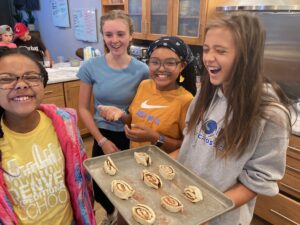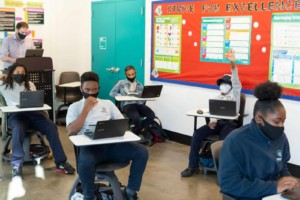Creating a Culture of Collaborative Family Engagement

Educational researchers and policymakers have come to realize that family engagement should be a primary rather than peripheral part of teaching and learning. As the spotlight has shifted to the role that families can play in education, many schools are scrambling to identify a starting point for how to invite families into student learning. A key consideration for schools as they seek to increase family engagement must be how to truly connect the various stakeholders of the school community and sustain those connections over time. In order for family engagement to be meaningful and lasting, the goal must be to create a systemic culture of collaboration (rather than piecemeal or isolated efforts) that can grow and evolve with the needs of students, parents and teachers.
To build a culture of collaborative family engagement, the following are useful practices.
Develop and support two-way communication between teachers and parents. Developing effective two-way communication requires several layers. First, consider the best method(s) to reach families. Email, text message, or app-based communication, through a platform like SeeSaw, can create an efficient and low-pressure pathway for communicating back and forth. Then, consider ways to encourage parents and families to engage and respond to your communication. If you share a video of Guided Reading, for example, invite parents to send questions or celebrations. Many parents only hear from teachers or schools in the event of a problem or concern. Try to initiate positive or neutral communication with families. Engaging in non-judgemental forms of communication lays the foundation for strong, collaborative relationships between teachers and parents. The more connected parents feel to the teacher and school, the more likely they are to actively engage in learning with their children. Furthermore, parents are experts on their own children. When they feel comfortable communicating, teachers can gain insights into students’ strengths, weaknesses, triumphs, or worries. Lastly, assess your system of communication regularly throughout the school year. Ask: Is this form of communication working for all of my families? Have I had an exchange with everyone at some point this year? Make modifications as needed.
Encourage communication among parents. While not directly “family engagement,” engaging families with one another helps to strengthen a school community. As new families enter the school, parents can serve as mentors in bringing them into the fold of the collaborative culture. Consider ways to encourage families to connect with one another. Use Edmodo or a closed Facebook group to give parents an easy way to share information or connect. As a teacher, invite parents to join you at a parent-teacher association meeting early in the year and make a special effort to introduce families to one another. At an after-school event, work to introduce families new to the area. Encourage parents with experience at the school to reach out to new families.
Consider parents’ perspectives. In an effort to promote inclusion of all families, and with a special consideration to the families whose children need support the most, regularly assess the impact of whole-school systems and processes on any and all families. For example, consider the cost of field trips and other school initiatives on families. How can schools ensure that all children can participate and that all families feel comfortable and welcome with the decision? Consider how to make school events available to all parents and families. Consider streaming meetings using Zoom. Utilize translators for any and all events, even PTA events not directly organized by the school. Every effort toward inclusiveness of all families creates a ripple that results in a much larger movement within the community.
Move beyond event-based engagement. Unquestionably, there is value in opening the school doors and welcoming families to participate in school events like Open House, Curriculum Night, or an Arts Showcase. These events can prove much more meaningful, however, when they are reframed as being part of broader conversations and connections between the school and families. Think about each parent-facing event as a catalyst for the development of true family engagement. When planning these events, brainstorm with other teachers about how to use this time with families to start a conversation about learning that continues after the culmination of the event. Use an event early in the year, for example, to model how families can support learning at home. Discuss how to enrich the experience of reading with your child by discussing pictures and making connections to the outside world. Utilize tools like PowerMyLearning’s Playlists to connect families to the standards students are learning in your classroom. Building these skills can have positive lifelong implications that reach far greater than the impact of a special event.
Encourage families to engage with their children in ways that are integrated with the overall curriculum. Engagement tied to instruction is more impactful for student success. Utilize multimodal communication to tell families about what students are learning, and give them ideas about how to extend and enrich that learning at home. These kinds of activities can even replace traditional homework. Students learning about fractions might spend a weekend baking in the kitchen. Students learning about sorting might help organize toys or laundry. Students learning about trees might lead their family on a nature hike. By giving families ideas about how to connect home conversations and activities to the curriculum, students’ instruction is enriched.
Find ways to build parents’ knowledge and confidence. Take time to develop the skills of parents and families in your classroom and in your school. Teach parents by sharing ideas and modeling instruction through photographs or short video clips. Consider using a private channel on Instagram to share best practice instruction and creative ways to extend learning. Sometimes, a simple image of students practicing letters with shaving cream or searching for 90 degree angles on a walk around the school can give parents new ideas to continue learning at home. Remind parents that they are partners in their child’s education and thank them for all of the ways they build up their child. Emphasize that activities like playing I Spy while running errands, pointing out the number sequence of mailboxes at the post office, and taking turns during Game Night at home all promote school readiness behaviors and encourage creativity and critical thinking. Taking time to build parents’ confidence and expertise supports the effort of teachers.
Most parents want to do what is best for their children. They want their kids to succeed in school. They want to provide a supportive and enriching environment at home. Many parents, however, are uncertain how to best do this and rely on schools to take the lead in their children’s educational endeavors. When schools reach out to parents as collaborators in educating students, all stakeholders benefit: Parents are empowered to take an active role and are given tools to make time at home, in the car, and anywhere else productive and meaningful. Teachers are supported, with active and committed partners working toward common educational goals, at school and at home. And students learn and grow in mutually supportive and complementary home and school environments. Though it takes effort and intention to create a systemic culture of family engagement, the results can have a tremendous impact on school communities.
For more, see:
- Family Playlists: A New Approach to Family Engagement
- The Results Are In On Student Engagement
- How to Reduce Barriers to Family Engagement
Stay in-the-know with all things EdTech and innovations in learning by signing up to receive our weekly newsletter, Smart Update.







Sanja Buha
It is not easy to communicate with parents, but, in my opinion, the more you email, text or call them you build a better relationship. Especially, when you hae multicultural and diverse population in your classroom.